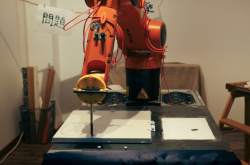Development of AI and robotics
The robotics market grows by 8-9% annually, and the amount of robotics in the services industry is expected to increase by 25%, said Fabio Bonsignorio, a professor at the Biorobotics Institute at Sant'Anna School of Advanced Studies in Pisa, Italy. Humanity is advancing towards the fourth industrial revolution with the Internet of Things, new jobs and communication technologies. Artificial intelligence is no longer seen as a reproduction of human cognitive functions, but as something that interacts with its environment and carries out certain actions.
According to Prof. Bonsignorio, there are currently two different models of creation and interaction for robots and AI:
- Reliability-based. This is, for instance, Google’s preferred model; the company’s unmanned cars have no steering wheels, meaning that the invention has to be tested extensively in order to be used by humans.
- Safeguard-based. A model typical for, say, Tesla: the company’s cars are equipped with numerous AI-based functions, but the responsibility for their use lies on the human driver, who can take over the controls at any time.
The future population of Earth won’t be able to live without AI. By 2050, it will almost reach 10 billion. The average age is increasing, and future generations will encounter numerous challenges related to climate change and urban sprawl; some of these will require the help of robots and AI. Experts believe that a leap in AI development will occur in the next 15 years due to computation becoming steadily cheaper and faster thanks to quantum computing. Blockchain, meanwhile, can provide easier access to regulation and financing, ensuring freedom and transparency in contract-making.

Direct democracy in a robot economy
In their report, Aleksandr Kapitonov and Sergei Lonshakov described the principles of robonomics, i.e. economy of robots. What is that? Essentially, it is an economy in which robots and humans communicate without middlemen. Robots provide services by making smart contracts with each other in a blockchain system. Humans make smart contracts with robots in a similar way; for example, if you crave a pizza, you can use a blockchain system to send your order and payment. Robots will process the order, prepare the food and send it to a delivery service where a drone will pick it up and deliver it to your door.
What are the risks of such a system? The key issue, as Aleksandr and Sergei pointed out, is monopolization. There’s a possibility of an IT company becoming a “middle layer” that will receive the orders and redistribute them to robots. After all, companies and developers are the ones who are currently in charge of creating and managing robonomics systems. That’s why we need to create a social and economic structure that will prevent any monopolies in robonomics and provide equal access to all services for all users (read more about robonomics and its risks here).
The discussion also touched upon the issues of regulatory policies in finance. Today, major IT companies accumulate massive earnings from their activities. But robonomics will entail a shift from the companies’ interests towards the interests of the public. In a perfect world, the companies will not be needed at all, as the system will be sustained by the collective efforts of its users, just like in blockchain.

“For example, I could put carbon dioxide sensors in my home and get paid for providing the data to an environment monitoring network. We presented the concept of robonomics as a direct democracy where people help form information streams, verify data and create their environment. In the end, we’ll have the tools to help large numbers of people cooperate on tasks. Many say: “Do people even need this?” Here’s a good example: several decades ago, waste sorting was nearly non-existent in Europe. Today, it’s pretty much everywhere. This result was achieved not only through regulation but by cultivating the public consciousness,” – explained Aleksandr Kapitonov.
Law, patents, and audits
It must be kept in mind, however, that robots and AI are the result of someone’s work, and are intellectual property. These judicial aspects were pointed out by Andrea Bertolini, a research fellow in Private Law at Sant'Anna School of Advanced Studies in Pisa, Italy. Someone creates and will create robonomics devices and has the right to be rewarded for their work. Besides, robots and AI-based services are products that will be used by consumers. Therefore, their manufacturers will bear responsibility for any damage done to users due to malfunction.
At the same time, legal decisions in regards to protection of consumers’ rights and intellectual property rights are quite different across Europe, and a unified legal framework must be formed. Another issue is that it’s impossible to assess the risks related to the integration of AI systems, which is why the systems must be tested extensively.

“Let’s imagine there’s an AI that designs parts. Who owns the intellectual rights to these designs? Those who use the program, not its developers. Our European colleagues, perhaps, don’t take into account open technologies, which is when a community uses code without ever needing a license to use it. For now, a scenario in which the products of a robot’s code don’t belong to the developer is not being considered by the regulatory bodies. We, on the other hand, are saying that if we wish to create lengthy, automated supply chains, the human presence in these chains must be minimal,” – commented Aleksandr Kapitonov.
In regards to liability for damage caused by the operation of AI systems, he added that in the western world these cases will likely be resolved on an individual basis according to common law. In Russia, the system is different: if a chain of events has led to a negative outcome, and the chain is too long, meaning that the responsibility is spread through all its parts, it’s impossible to find a guilty party.
Systems must also be audited with minimal human participation. An audit is a necessary element of robonomics. It can be carried out based on data from independent measurements done by sensors. Although at first, it is likely that humans will need to verify this data.

Society’s role in robonomics
One of the most important questions related to the introduction of AI systems and robonomics is how the society will react to this technology. Society isn’t just social groups, but political ones, too. Political decisions based on an incorrect perception of robonomics may lead to unfavorable consequences. That’s why it’s important to be aware of the “hype cycles” of technologies and not to rush with decisions until a technology is actually seeing a practical application, assured Massimo Moggi, a professional affiliate at Sant'Anna School of Advanced Studies in Pisa, Italy.
The pros and cons of AI must be taken into account when creating social policy, stressed Toshie Takahashi, a professor at the School of Culture, Media and Society at Waseda University (Japan). Among the pros of AI are predictability of results, lower production costs, stability, self-replication. The cons are unpredictability, ethics and liability issues, social polarization, human identity crisis. According to Prof. Takahashi, the society will gradually set down norms of existence in a robotized environment, but that won’t happen immediately. Per the surveys carried out by the professor herself, younger people would prefer not to see robots involved in healthcare (45%), elder care and child-raising (40%) and education (25%). Around 90% of the respondents wanted robot-made decisions to be checked by humans. Half of the respondents were willing to participate in creating a world where humans would coexist with robots.

Business processes and education
It’s no secret that people are worried about robots and AI taking their jobs. A harmonious co-existence with robots in the business environment is a must in regards to the society embracing the new economy. Mark Skilton, a professor at the University of Warwick’s Business School, expanded on the matter during the workshop.
The introduction of AI and robots will change the existing business processes. That doesn’t mean that robots will necessarily take others’ jobs. The task of the business community is to change humans’ job requirements in accordance with the changing economic model. Right now, scientists and their partners in the industry must understand just what effect AI will have on human workers’ efficiency, the job market, the various companies business strategies and production methods. This is needed in order to redirect human resources towards the goals that will be more relevant in the new circumstances. According to McKinsey & Company, in 20 years AI will affect 45% of all jobs: from factory workers and farmers to doctors and lawyers.
For example, future machines used in the automation of manufacturing will likely be too complicated compared to today’s production technologies. AI systems will need new methods, too, like 3D-printing. Knowing all that, we need to consider what sort of work humans will carry out in such environments.
“Another matter that was brought up after the reports is that people and the society aren’t prepared to play by the new rules that are dictated by technology. Students who graduate don’t possess the skills that are currently relevant. The experts noted that we need to start thinking how to change the educational process not only in universities but in schools as well,” – said Aleksandr Kapitonov.






